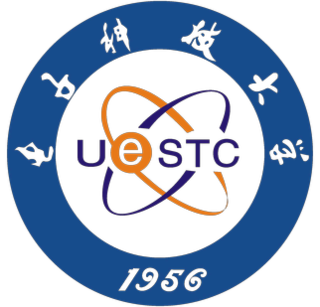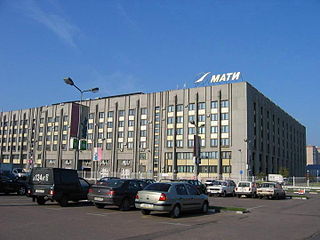
Harbin Institute of Technology is a research university and a member of China's elite C9 League. HIT is a Chinese Ministry of Education Class A Double First Class University. It has three campuses, spanning the country from north to south: the Harbin campus in Heilongjiang Province, the Weihai campus in Shandong Province and the Shenzhen campus in Guangdong Province.

Beijing Institute of Technology, is a national leading co-educational public university, located in Beijing, China. It was established in 1940 in Yan'an, Shaanxi. It is a major research university under the supervision of the Ministry of Industry and Information Technology.

Nanjing University of Aeronautics and Astronautics (NUAA), known colloquially as Nanhang (南航), is an elite, Chinese Ministry of Education Double First Class Discipline University, with Double First Class status in certain disciplines. Located in Nanjing, Jiangsu province, it was established in 1952 and is now operated by the Chinese Ministry of Industry and Information Technology. Nanhang is ranked in the top 250 universities in the world in the QS World University Rankings for Mechanical, Aeronautical and Manufacturing Engineering. It is among top 300 institutions of Asia, according to QS World University Rankings and Times Higher Education World University Rankings. According to SCImago Institutions Rankings, NUAA is among the top 500 institutions of the world.

Jilin University located in Changchun, founded in 1946, is a leading national research university under the direct jurisdiction of China's Ministry of Education. It is a Chinese Ministry of Education Class A Double First Class University. It is strongly supported by state key projects such as Project 985, Project 211 and Project 2011. Jilin University is consistently ranked as one of the most prestigious universities in China, and has research projects in automobile engineering, chemistry, computer science, electrical engineering and biology be identified as internationally renowned. In 2017, the university is supported to achieve "world-class" academic status under the Double First Class University Plan by China. JLU's alumni include the Vice Premier of the People's Republic of China Liu Yandong, and 2010 Nobel Peace Prize winner Liu Xiaobo.

Moscow Aviation Institute founded in 1930 is one of several major engineering higher education establishments in Moscow. Since its inception MAI has been spearheading advances in aerospace technology both within Russia and worldwide. The university laid emphasis on laboratory instruction in applied science and engineering, specific to demands of the aerospace industry. During World War II part of the university was evacuated to Almaty Kazakhstan, the university, staff and students continued to work on research and wartime production throughout the war. During the Post-War period, the university expanded and assimilated new technologies during the Jet age. Research conducted in the university contributed to heralding the space age.

Shanghai Nanyang Model High School, often referred to simply as Nanmo, is one of the oldest modern Chinese schools, founded in 1901 by Sheng Xuanhuai, Minister of Transportation of the Qing Dynasty.

Northeast Agricultural University was established in 1948 in Harbin, Heilongjiang Province, People's Republic of China.

Paul K. Chu (朱劍豪) is a specialist in plasma surface modification and materials science. He is Chair Professor of Materials Engineering at City University of Hong Kong.

Harbin University of Science and Technology is a university in Harbin, China. Previously known as Harbin University of Science and Technology. It is colloquially known as Hakeda, or Harbin Institute of Electrical Technology(Chinese: 哈尔滨电工学院; pinyin: Hā'ěrbīn Diàn'gōng Xuèyuàn). It is colloquially known as Hadiangong.

University of Electronic Science and Technology of China (UESTC) is a Chinese national key university in Chengdu, Sichuan, and a Class A Double First Class University directly under the Ministry of Education. UESTC was included as one of the first universities into "Project 211" in 1997, and then the nation's “Project 985” in 2001. After more than sixty years of development, UESTC now has evolved into a key multidisciplinary university covering all-around programs in electronic disciplines with electronic science and technology as its nucleus, engineering as its major field and a harmonious integration of science, engineering, management, liberal arts and medical science.
Ye Peijian is a Chinese aerospace engineer. He is the Chief Commander and Chief Designer of the Chinese Lunar Exploration Program.

Moscow State Aviation Technological University is a university in Moscow, Russia. The modern name of this university is «MATI» - Russian State University of Aviation Technology. It is named after the Russian aeronautics and rocketry pioneer Konstantin Eduardovich Tsiolkovskii.

Northeast Forestry University, located in Harbin, Heilongjiang Province, is an institution of higher education and research under jurisdiction of the Ministry of Education of the People's Republic of China, serve as the largest forestry university in China and a key university within the scope of national "211 Project". It is a Chinese Ministry of Education Double First Class Discipline University, with Double First Class status in certain disciplines.

The China University of Petroleum - Beijing (CUPB) is a Chinese university with campuses in Beijing and Karamay. It is part of the China University of Petroleum.

Samara National Research University, in is one of Russia's leading engineering and technical institutions. It is located in the City of Samara.
Ren Xinmin was a Chinese aerospace engineer and a specialist in astronautics and liquid rocket engine technology. He was the technical director of the Long March 1 rocket, which launched the Dong Fang Hong I, China's first satellite, and the chief designer of Chinese storable propellant rocket engine. He was also the chief designer for Long March 3 launch vehicle, Fengyun, and SJ (Shijian) series satellites.
Ma Zuguang was a Chinese physicist. He is an expert in optoelectronic technology and professor of Harbin Institute of Technology (HIT). Ma founded two disciplines at HIT, nuclear physics and laser technology. He also founded the Tunable Laser Laboratory, a state-level key laboratory. He was an academician of the Chinese Academy of Sciences.
Huang Weilu was a Chinese aerospace and electrical engineer who was a specialist in the control systems of missiles and rockets. The chief designer of JL-1, China's first submarine-launched ballistic missile (SLBM), he was awarded the Two Bombs, One Satellite Meritorious Medal in 1999 and the Highest Achievement Award of China's aerospace industry in 2006. He was an academician of the Chinese Academy of Sciences and the International Academy of Astronautics.
Liang Shoupan was a Chinese aerospace engineer. The chief designer of China's first generation of anti-ship missiles including the HY-1 and HY-2, he is regarded as the "father of China's cruise missile program". He also designed the C-101, C-801 and other missiles. He was an academician of the Chinese Academy of Sciences and the International Academy of Astronautics. In 2006, he was one of the five scientists who received the Highest Achievement Award of China's aerospace industry.

Wang Xiji is a Chinese aerospace engineer. The chief designer of China's first sounding rocket (T-7), first space launch vehicle and first recoverable satellites, he was awarded the Two Bombs, One Satellite Meritorious Medal in 1999. He is an academician of the Chinese Academy of Sciences and the International Academy of Astronautics, and was inducted into the International Astronautical Federation Hall of Fame in 2016.















